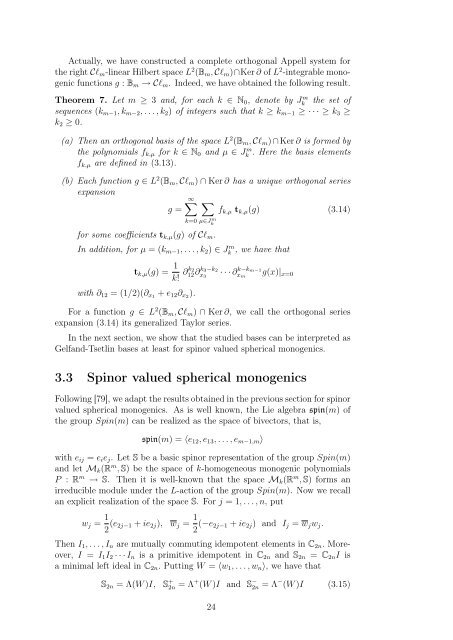Hypercomplex Analysis Selected Topics
Hypercomplex Analysis Selected Topics
Hypercomplex Analysis Selected Topics
Create successful ePaper yourself
Turn your PDF publications into a flip-book with our unique Google optimized e-Paper software.
Actually, we have constructed a complete orthogonal Appell system for<br />
the right Cℓm-linear Hilbert space L 2 (Bm, Cℓm)∩Ker ∂ of L 2 -integrable monogenic<br />
functions g : Bm → Cℓm. Indeed, we have obtained the following result.<br />
Theorem 7. Let m ≥ 3 and, for each k ∈ N0, denote by J m k the set of<br />
sequences (km−1, km−2, . . . , k2) of integers such that k ≥ km−1 ≥ · · · ≥ k3 ≥<br />
k2 ≥ 0.<br />
(a) Then an orthogonal basis of the space L2 (Bm, Cℓm) ∩Ker ∂ is formed by<br />
the polynomials fk,µ for k ∈ N0 and µ ∈ J m k . Here the basis elements<br />
fk,µ are defined in (3.13).<br />
(b) Each function g ∈ L2 (Bm, Cℓm) ∩ Ker ∂ has a unique orthogonal series<br />
expansion<br />
∞ <br />
g = fk,µ tk,µ(g) (3.14)<br />
k=0 µ∈J m k<br />
for some coefficients tk,µ(g) of Cℓm.<br />
In addition, for µ = (km−1, . . . , k2) ∈ J m k<br />
tk,µ(g) = 1<br />
k! ∂k2 12∂ k3−k2<br />
x3<br />
with ∂12 = (1/2)(∂x1 + e12∂x2).<br />
, we have that<br />
· · · ∂ k−km−1<br />
xm g(x)|x=0<br />
For a function g ∈ L 2 (Bm, Cℓm) ∩ Ker ∂, we call the orthogonal series<br />
expansion (3.14) its generalized Taylor series.<br />
In the next section, we show that the studied bases can be interpreted as<br />
Gelfand-Tsetlin bases at least for spinor valued spherical monogenics.<br />
3.3 Spinor valued spherical monogenics<br />
Following [79], we adapt the results obtained in the previous section for spinor<br />
valued spherical monogenics. As is well known, the Lie algebra spin(m) of<br />
the group Spin(m) can be realized as the space of bivectors, that is,<br />
spin(m) = 〈e12, e13, . . . , em−1,m〉<br />
with eij = eiej. Let S be a basic spinor representation of the group Spin(m)<br />
and let Mk(R m , S) be the space of k-homogeneous monogenic polynomials<br />
P : R m → S. Then it is well-known that the space Mk(R m , S) forms an<br />
irreducible module under the L-action of the group Spin(m). Now we recall<br />
an explicit realization of the space S. For j = 1, . . . , n, put<br />
wj = 1<br />
2 (e2j−1 + ie2j), wj = 1<br />
2 (−e2j−1 + ie2j) and Ij = wjwj.<br />
Then I1, . . . , In are mutually commuting idempotent elements in C2n. Moreover,<br />
I = I1I2 · · · In is a primitive idempotent in C2n and S2n = C2nI is<br />
a minimal left ideal in C2n. Putting W = 〈w1, . . . , wn〉, we have that<br />
S2n = Λ(W )I, S + 2n = Λ + (W )I and S − 2n = Λ − (W )I (3.15)<br />
24

















